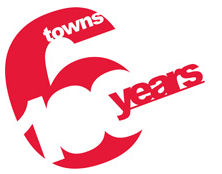31st March 1910 saw the federation of the
six towns to form the County Borough of Stoke-on-Trent
|
Stoke-on-Trent Local
History |
|
|
|
|
| Federation of the six towns 31st March 1910 saw the federation of the six towns to form the County Borough of Stoke-on-Trent |
![]()
![]()
![]()
next: Conservatism
previous: The Labour Party
contents: Index page for
Federation


Federation article by local
historian - Fred Hughes
People who made the Potteries - Plant and Bennett
|
On 24th April 1945, major plans were unveiled for the reconstruction of Stoke-on-Trent. This pioneering document had been prepared by the council's chief planning officer, James Plant, an academic architect who was under no illusion that he would be the man who would transform Stoke-on-Trent into a powerhouse for regional development and enterprise.
Similar plans were drawn for Longton and Burslem but unfortunately post-war austerity defeated Plant's imaginative creation and it was shelved for fifteen years until a spirited new council leader name Albert Bennett resurrected them. Bennett was born in Leicester in 1901 and worked in the coal mines from the age of 13. His confrontational nature inevitably drew him to union activity when, during the General Strike of 1926, he was made secretary for the Leicester Council for Action giving his colliery boss the best reason of all to sack his insistent troublemaker. As a member of the Labour Party, Bennett turned his union background into a political career when he was sent to Stoke-on-Trent in 1935 as a representative of the railwaymen's union. By the time he was elected to the council in 1944 he had virtually taken over all the major positions in Stoke-on-Trent's Labour Movement including presidency of the then powerful North Staffs Trades Council. He was a natural organiser and quickly realised the advantage of having a shield of lieutenants recruited from the dominant railway unions. Between 1960 and 1970 there were 14 locomotive men in what was jokily called the train-driver's council. This gang of plate-men and shunters became celebrated inasmuch as it included such well-known future Lord Mayors and council leaders as Horace Barks, Tom Beddow, Arthur Moran, Arthur Cholerton and Jim Westwood. It was even said that certain rail lines had to be suspended when the locomotive councillors were called to a full council meeting at the same time. From this unassailable platform Albert Bennett set about changing the face of Stoke-on-Trent. Seeing that little physical development had occurred and certainly nothing of any architectural value had been built since 1910, his philosophy was simple - too many buildings of little economic value were occupying sites of great monetary value; the old should move over for the new.
As hundreds of terraced houses were demolished a new police station and fire station, library and museum, were relocated to John Street and Bethesda Street. And Bennett's 'precinct-shopping' was integrated in a brand new bus station as the face of old Hanley changed forever. Nor did Bennett ignore the other towns. Plant's designs for the reconstruction of Longton town centre were also implemented as the novelty of precinct shopping caught on. Similar projects were launched in Burslem starting with the controversial demolition of the Victorian market superseded by open-air leisure space. Like Longton's Bennett Precinct, Burslem's Bennett Gardens was named after the council's radical leader.
Pevsner - "The Buildings of England"
Bennett's dazzling city was intended to reflect the modernization of traditional industry aimed at attracting diverse enterprise. Unhelpfully, though, the anticipated new business failed to materialise in sufficient measure. Even worse was the meddling intrusion of a parliament that wanted to create greater-councils. As the seventies opened the very existence of Stoke-on-Trent as a first-tier local authority was threatened and the fulfilment of Bennett and Plant's dreams were curtailed. Bennett died in 1972 and the City looked to other inspirational leaders to finish the job. |
![]()
![]()
![]()
next: Conservatism
previous: The Labour Party
contents: Index page for
Federation